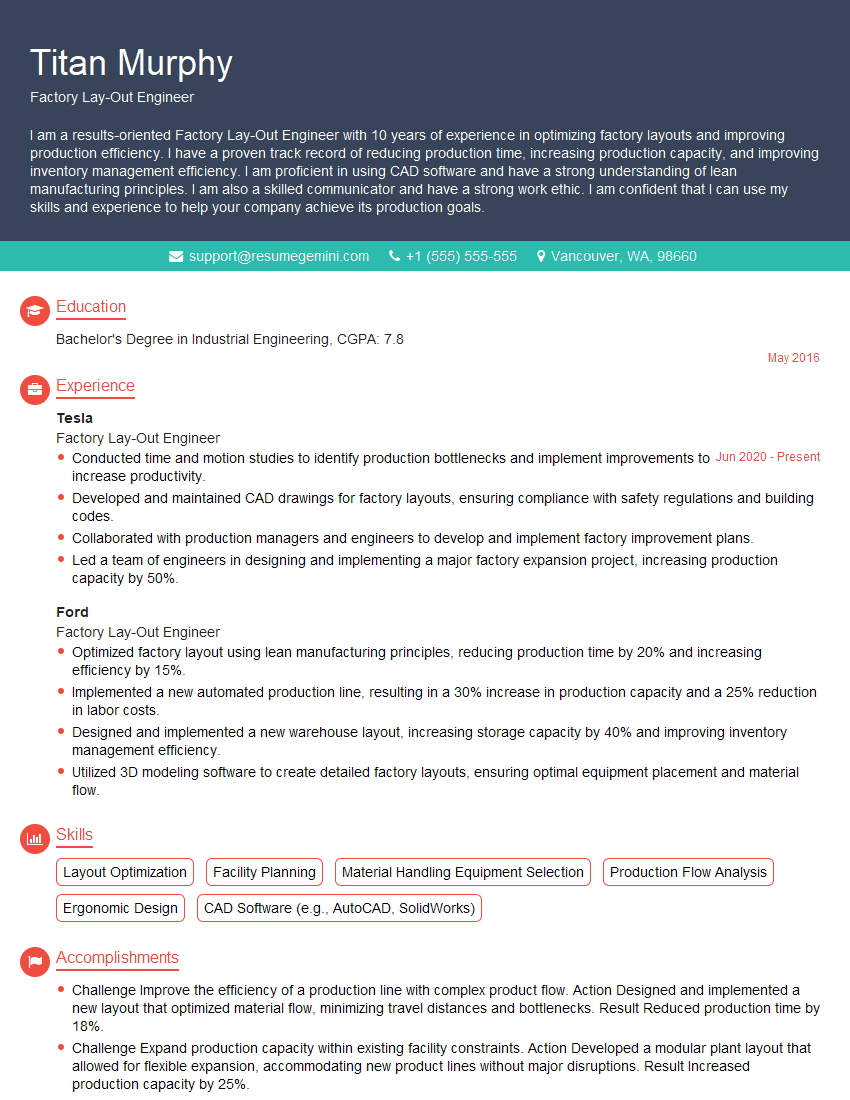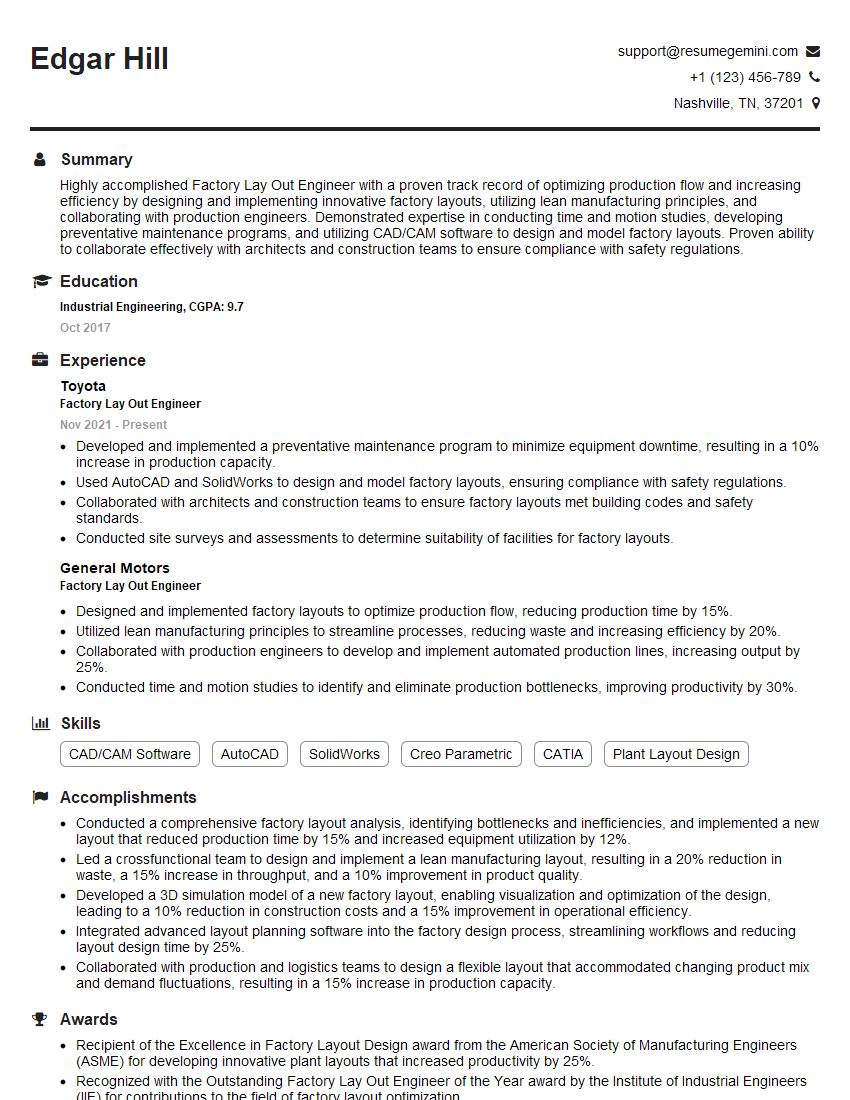Are you gearing up for an interview for a Factory Lay-Out Engineer position? Whether you’re a seasoned professional or just stepping into the role, understanding what’s expected can make all the difference. In this blog, we dive deep into the essential interview questions for Factory Lay-Out Engineer and break down the key responsibilities of the role. By exploring these insights, you’ll gain a clearer picture of what employers are looking for and how you can stand out. Read on to equip yourself with the knowledge and confidence needed to ace your next interview and land your dream job!
Acing the interview is crucial, but landing one requires a compelling resume that gets you noticed. Crafting a professional document that highlights your skills and experience is the first step toward interview success. ResumeGemini can help you build a standout resume that gets you called in for that dream job.
Essential Interview Questions For Factory Lay-Out Engineer
1. Describe the key steps involved in developing a factory layout?
- Identify the project scope and constraints.
- Collect and analyze data on the existing facility, production processes, and equipment.
- Develop and evaluate alternative layout concepts.
- Select the most appropriate layout and develop a detailed design.
- Implement the layout and evaluate its performance.
2. What are the different types of factory layouts?
Process layout
- Machines and equipment are grouped together based on their function.
- Suitable for low-volume, high-variety production.
- Advantages: Flexibility, low capital investment.
- Disadvantages: High labor costs, inefficient material flow.
Product layout
- Machines and equipment are arranged in a sequence that follows the production process.
- Suitable for high-volume, low-variety production.
- Advantages: Efficient material flow, high productivity.
- Disadvantages: Inflexible, high capital investment.
Cellular layout
- Machines and equipment are grouped together to create specialized work cells.
- Suitable for medium-volume, medium-variety production.
- Advantages: Flexible, efficient material flow.
- Disadvantages: Requires skilled labor, can be complex to implement.
3. What are the key factors to consider when selecting a factory layout?
- Production volume and variety.
- Equipment and space requirements.
- Material flow patterns.
- Labor requirements.
- Safety and ergonomics.
4. What are the advantages of using computer-aided design (CAD) software in factory layout planning?
- Improved accuracy and precision.
- Faster design time.
- Ability to simulate material flow and equipment operations.
- Easier to make changes and revisions.
- Better communication with other stakeholders.
5. What are the common challenges faced by factory layout engineers?
- Balancing the need for efficiency with the need for flexibility.
- Accommodating changes in production volume and product mix.
- Integrating new equipment and technology.
- Meeting safety and environmental regulations.
- Working within budget and time constraints.
6. What are the latest trends in factory layout design?
- Increased use of automation and robotics.
- Adoption of lean manufacturing principles.
- Focus on sustainability and energy efficiency.
- Use of data analytics to optimize layout and operations.
- Integration with digital technologies such as IoT and cloud computing.
7. What is your experience in using simulation software for factory layout planning?
- Describe the software you have used and your level of proficiency.
- Provide examples of projects where you have used simulation to optimize factory layouts.
- Discuss the benefits and challenges of using simulation software.
8. How do you stay up-to-date with the latest trends and advancements in factory layout design?
- Attend industry conferences and workshops.
- Read trade publications and technical journals.
- Network with other factory layout engineers.
- Take online courses and certifications.
9. What are your strengths and weaknesses as a factory layout engineer?
Strengths
- Strong understanding of factory layout principles.
- Proficient in CAD software.
- Excellent problem-solving and analytical skills.
- Ability to work independently and as part of a team.
- Commitment to continuous learning and improvement.
Weaknesses
- Limited experience with certain types of production processes.
- Can be sometimes too detail-oriented.
- Working under tight deadlines can be stressful.
10. Why are you interested in this factory layout engineer position?
- Explain your interest in the company and the role.
- Describe how your skills and experience align with the requirements of the position.
- Express your enthusiasm for the opportunity to contribute to the company’s success.
Additional questions that may be asked:
- Can you describe a project where you successfully optimized a factory layout?
- How do you handle conflicting requirements from different stakeholders?
- What are your thoughts on the future of factory layout design?
Interviewers often ask about specific skills and experiences. With ResumeGemini‘s customizable templates, you can tailor your resume to showcase the skills most relevant to the position, making a powerful first impression. Also check out Resume Template specially tailored for Factory Lay-Out Engineer.
Career Expert Tips:
- Ace those interviews! Prepare effectively by reviewing the Top 50 Most Common Interview Questions on ResumeGemini.
- Navigate your job search with confidence! Explore a wide range of Career Tips on ResumeGemini. Learn about common challenges and recommendations to overcome them.
- Craft the perfect resume! Master the Art of Resume Writing with ResumeGemini’s guide. Showcase your unique qualifications and achievements effectively.
- Great Savings With New Year Deals and Discounts! In 2025, boost your job search and build your dream resume with ResumeGemini’s ATS optimized templates.
Researching the company and tailoring your answers is essential. Once you have a clear understanding of the Factory Lay-Out Engineer‘s requirements, you can use ResumeGemini to adjust your resume to perfectly match the job description.
Key Job Responsibilities
Factory Lay-Out Engineers, with their comprehensive knowledge of manufacturing processes, automation, and space planning, play a vital role in optimizing production lines and improving factory efficiency.
1. Design and Optimization of Factory Layouts
Factory Lay-Out Engineers are responsible for designing and optimizing the physical layout of manufacturing facilities, considering factors like production flow, equipment placement, material handling, inventory storage, and employee safety.
- Develops and implements efficient factory layouts that maximize productivity and minimize downtime.
- Conducts time and motion studies to determine optimal workstation configurations and material flow.
2. Equipment Selection and Placement
They determine the type, quantity, and placement of machinery and equipment to ensure smooth production flow and minimize bottlenecks.
- Evaluates and selects appropriate equipment based on production requirements and space constraints.
- Determines optimal equipment placement to facilitate efficient material handling and minimize production disruptions.
3. Material Flow Analysis and Improvement
Factory Lay-Out Engineers analyze material flow patterns to identify inefficiencies and implement solutions for smoother, faster, and cost-effective material handling.
- Designs and implements material handling systems, including conveyors, forklifts, and automated guided vehicles (AGVs).
- Evaluates material flow patterns and identifies bottlenecks and inefficiencies.
4. Safety and Ergonomics Evaluation
They ensure that factory layouts adhere to safety regulations and promote employee health and well-being by considering factors like lighting, noise levels, and proper ventilation.
- Conducts safety and ergonomic assessments of factory layouts and recommends improvements.
- Collaborates with safety and health professionals to ensure compliance with regulations and promote a safe working environment.
Interview Tips
To ace the interview for a Factory Lay-Out Engineer position, it’s crucial to prepare thoroughly and highlight your skills and experience that align with the key responsibilities.
1. Research the Company and Industry
Demonstrate your interest in the company and industry by researching their products, services, recent projects, and industry trends. This knowledge will help you understand their specific requirements and tailor your answers accordingly.
- Visit the company’s website and LinkedIn page to gather information about their operations, culture, and values.
- Read industry publications and attend webinars to stay updated on the latest advancements and best practices.
2. Quantify Your Experience
When describing your past experiences, use specific metrics and data to quantify your accomplishments. Quantifying your results demonstrates your impact on the organization and provides concrete evidence of your skills.
- Example: “I designed and implemented a new factory layout that reduced production time by 15% and waste by 20%.”
3. Showcase Your Technical Skills
Highlight your proficiency in using layout design software, such as AutoCAD or SolidWorks. Discuss your experience in designing and optimizing factory layouts, including considerations for production flow, equipment placement, and material handling.
- Be prepared to discuss specific projects where you applied your technical skills to solve problems and improve efficiency.
4. Emphasize Your Analytical Abilities
Factory Lay-Out Engineers need strong analytical skills to identify inefficiencies and develop solutions. Share examples where you analyzed production processes, identified bottlenecks, and implemented changes to improve performance.
- Describe how you used data analysis techniques to evaluate material flow patterns and determine optimal equipment placement.
5. Demonstrate Your Problem-Solving Skills
Interviewers want to know that you can think critically and solve problems effectively. Discuss situations where you faced challenges in factory layout design and how you overcame them. Explain your decision-making process and the outcomes you achieved.
- Example: “I encountered a space constraint when designing a new factory layout. I explored various options, including vertical storage solutions and reconfiguring equipment, to optimize the available space and maintain efficient production flow.”
Next Step:
Now that you’re armed with interview-winning answers and a deeper understanding of the Factory Lay-Out Engineer role, it’s time to take action! Does your resume accurately reflect your skills and experience for this position? If not, head over to ResumeGemini. Here, you’ll find all the tools and tips to craft a resume that gets noticed. Don’t let a weak resume hold you back from landing your dream job. Polish your resume, hit the “Build Your Resume” button, and watch your career take off! Remember, preparation is key, and ResumeGemini is your partner in interview success.

